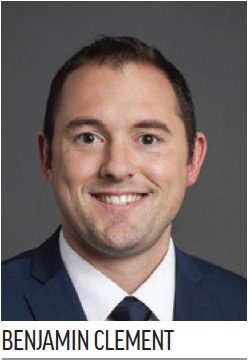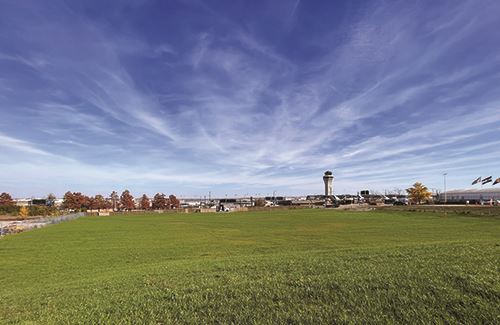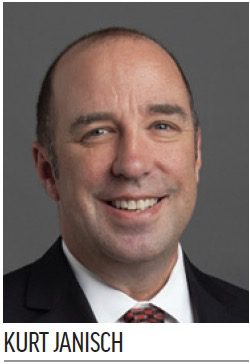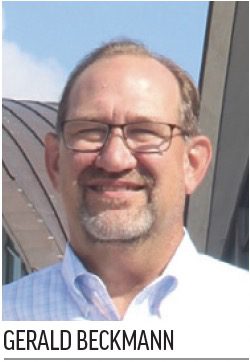When St. Louis Lambert International Airport (STL) opened its new $50 million jet fuel storage facility and updated hydrant system in August 2021, the project was widely acclaimed. After all, it doubled the airport’s fuel storage capacity to 3 million gallons, added the latest technology and made fueling operations at STL more efficient and environmentally friendly.
When St. Louis Lambert International Airport (STL) opened its new $50 million jet fuel storage facility and updated hydrant system in August 2021, the project was widely acclaimed. After all, it doubled the airport’s fuel storage capacity to 3 million gallons, added the latest technology and made fueling operations at STL more efficient and environmentally friendly.
The second, and arguably less glamorous, step was decommissioning and removing the old fuel facility. That project started in November 2021 and was completed in October 2022, at a cost of $8 million.
St. Louis Fuel Company LLC (STL Fuel), an airline consortium of American, Delta, Southwest and United, funded and managed both projects. It contracted Burns & McDonnell as the design builder for the two endeavors.
|
Project: Removing Old Fuel Farm Location: St. Louis Lambert Int’l Annual Operations: 160,000
Project Cost: $8 million (part of $100 million budget Scope: Removing 49 underground fuel storage tanks (41 jet fuel, 8 gasoline or diesel fuel) Owner/Operator: STL Fuel Company LLC (airline consortium) Key Benefits: Prevents fuel leaks near terminal; land is now available for future development Engineering Consultant: Burns & McDonnell Demolition: Spirtas Wrecking Abandoned Well Monitoring: Environmental Operations Fuel Consolidation & Evacuation: Kiesel Power Disconnection: Ameren Missouri Tanks & Fuel Line Cleaning/Impacted Liquids Disposal: Illini Environmental Soil & Solid Materials Disposal: Champ Landfill Fuel Transfer Line Decommissioning: Corrigan Non-Impacted Concrete & Gravel Disposal: 8370 Excavation Recyclable Metal Disposal: Grossman Iron & Steel Ferrous Metals Recycling: Advantage Metals Recycling; Alton Materials/Prairie State Salvage & Recycling Concrete Recycling: ECO Recycling Non-Ferrous Metals Recycling: Wallach Iron & Metal Refrigerant Recycling: Rapid Recovery Asbestos Disposal: Milam Landfill Impacted Soil & Borrow Source Soil Hauling: Revelle Trucking In-Place Grouting of Existing Fuel Transfer Lines: All Star Concrete Pumping Compaction Testing & Surveying: ABNA Engineering Electrical Connections: RJP Electric Clean Fill Topsoil Borrow Source: 370 Crossing |
Even before construction of the new fuel farm began in 2019, Burns & McDonnell began working with the airport to plan the decommissioning and removal project. “Several of our departments were involved in the process of planning how we could remove the old tanks safely,” recalls Gerald Beckmann, the airport’s deputy director for Planning and Development. “We had representatives from Engineering, Environmental, Planning, Legal and Properties. And several regulators from outside agencies were also involved at one point or another.”
The former fuel storage facility at STL was one of the oldest and largest underground storage tank systems at a U.S. airport, with 49 underground storage receptacles. Forty-one of the tanks, ranging in capacity from 30,000 gallons to 60,000 gallons, held jet fuel; the other eight contained gasoline or diesel fuel. And all of them needed to be removed.
“Many of these tanks were built in the 1950s, so we had to be very careful to make sure they were not leaking any contents during their removal,” Beckmann emphasizes.
The location of the old fuel farm also presented several challenges. It was only 200 yards away from Terminal 1 and adjacent to the airport’s main entrance road and Parking Lot A. In addition, the 49 tanks were crammed together on only three acres.
Construction vehicles had to use the same main access road into the airport as passenger vehicles, shuttle vans and other traffic. And there was not a convenient staging area for construction equipment.
Kurt Janisch, a project manager with Burns & McDonnell’s Aviation and Federal Group, details the complex process used to remove the tanks safely: “The first step was disconnecting the pump system from the hydrant system, to separate each tank. The operator initially extracted as much usable fuel as possible from each tank, and sent it via the hydrant system transfer lines to the new storage facility. Once there, the fuel was pumped through filters into one of the main storage tanks in the new fuel station. Several inches of fuel, which likely contained the most sediment, were left on purpose in each of the old tanks. This remaining fuel was removed and transported by truck to a recycling company. At that plant, it was converted from aviation fuel into diesel fuel or heating oil. The whole process for each tank took a couple of weeks.”
After all of the fuel was removed, another subcontractor used a very powerful power washer to clean the inside of each tank and extract the remaining water/fuel/sediment liquid. That material also was trucked off the property for disposal.
Once emptied, the tanks were then pulled out, cut up on-site and trucked away for recycling. Any other metal material, such as piping and pumps, also went to an off-site recycling plant.
Environmental Safeguards
A detailed work plan about environmental precautions was sent to the Missouri Department of Natural Resources (MDNR) before any work began. “This document covered remediation aspects of the proposed construction and decommissioning activities, and also contemplated possible unexpected issues that might develop,” states Benjamin Clement, associate geologist with Burns & McDonnell.
 Because the document was prepared during COVID, the project team held virtual meetings with personnel from STL Fuel, the airport and the state DNR. “With all the back-and-forth between the various stakeholders, and with their revisions, it probably took us more than a year to draft and finalize this plan,” Clement relates.
Because the document was prepared during COVID, the project team held virtual meetings with personnel from STL Fuel, the airport and the state DNR. “With all the back-and-forth between the various stakeholders, and with their revisions, it probably took us more than a year to draft and finalize this plan,” Clement relates.
A hazardous materials survey of the old operations building also was required before demolition. Because it was constructed in the 1950s when building materials with lead paint coatings or asbestos were sometimes used, various materials required testing before the operations building was torn down. Several samples collected prior to demolition confirmed that there was no asbestos-containing material in the building that required special disposal. However, some sections of the underground piping did contain asbestos. Those pipes were segregated and trucked to an off-site landfill for disposal.
As tanks and pipes were removed, a multifaceted process was used to test the soil surrounding those particular tanks. Testing was performed in four separate excavation areas because the tanks were placed at various depths and distances from each other. Burns & McDonnell personnel also tested the soil surrounding the pipes that connected the tanks, to assess whether fuel had leaked in these areas or migrated through these preferential pathways in the subsurface.
A Burns & McDonnell geologist used a photoionization detector to check for initial indications of volatile organic compounds in the soil as excavations advanced. If readings did not fall within a predetermined threshold, an additional field screening step was employed.
The on-site geologist then used field kits to screen for residual petroleum hydrocarbons in the soil. Soil was added with reagents and water in special jars, and then shaken. If the mixture changed color, indicating levels of petroleum hydrocarbons above a certain level, more soil from that area had to be removed. These screening steps were critical to efficiently directing excavation activities in real time, while reducing potential costly, wasteful or duplicative laboratory analyses.

It was particularly important to mark sections where soil samples were collected. Once the geologist collected a sample, he recorded GPS coordinates for that location, placed a flag in the ground to mark it, and took photos to further document his observations.
Members of the testing team used a mobile application called ArcGIS Collector, developed by ESRI, to remotely log samples and photos. If needed, the geologist could access a dashboard with symbols that showed where each sample was taken, with links to corresponding field and/or laboratory data.
After testing was complete in each section, contaminated soil was trucked out of the airport to a disposal site. Soil that tested as satisfactory was used as backfill.
Soil from two “borrow” sites—one owned by the airport—also were tested. Once soil was deemed clean, it was used as backfill as well.
 Janisch notes that recycling and reusing materials reduced the overall project cost by an estimated $500,000. It also reduced traffic congestion, lowered greenhouse gas emissions and minimized landfill waste.
Janisch notes that recycling and reusing materials reduced the overall project cost by an estimated $500,000. It also reduced traffic congestion, lowered greenhouse gas emissions and minimized landfill waste.
During construction activities that had the greatest potential to impact air quality, a sophisticated air monitoring system was used. Four passive air quality sampling devices were installed at strategic spots along the fence line at the site perimeter, to assess the potential presence and concentration of various organic compounds in ambient air around the perimeter of the construction site.
These devices collected samples of the air 24 hours a day, over a one-week period. Then, each device was sent to a certified laboratory for analysis, and a new one was deployed in the same spot for continuous data.
In addition, one person from Clement’s team walked the perimeter of the construction site several times throughout the workday, recording real-time air measurements with a photoionization detector equipped with additional instrumentation to measure benzene as well. Air monitoring personnel focused these additional readings at upwind and downwind locations of the site using an on-site meteorological system that was installed specifically for the project.
Fortunately, there were no air quality issues during the project, Clement reports. “Sometimes there would be odors, but field measurements and laboratory analyses confirmed the work activities were not creating an ambient air issue,” he adds.
Safety First
Janisch notes that safety procedures were carefully followed throughout the 11-month project. “We have a robust safety checklist that is reviewed on a daily basis,” he says. “It does not matter what the activity is, and it includes everyone on-site. The list includes all personal protective clothing, hardhats, safety glasses, vests, steel-lined boots and gloves. The on-site superintendent is in charge of monitoring that these procedures are being followed. We ask all contractors to emphasize safety to all of their workers from the get-go.”
On an average day, there were about 10 people on site. If Janisch was not personally on site, he would check with the superintendent in charge for a progress report each day.
Successful Conclusion
Beckmann reports that all stages of the decommissioning project went according to plan, and there were no safety incidents, regulatory violations or complaints from airport passengers or tenants.

Moreover, the airport terminal, public access roads and parking facilities all remained open during the project without disruption.
“This was the biggest underground tank decommissioning project in the state of Missouri, I believe,” says Beckmann. “I am very pleased that it went so well.”
With landscaping complete, STL now has three strategically located acres of open land that can be developed in the near future, and Beckmann expects it will be used in the next three or four years.
More information about STL’s new fuel facility is available in our October 2021 article: Bigger, Better Fuel Farm Comes Online at St. Louis Int’l


 facts&figures
facts&figures

